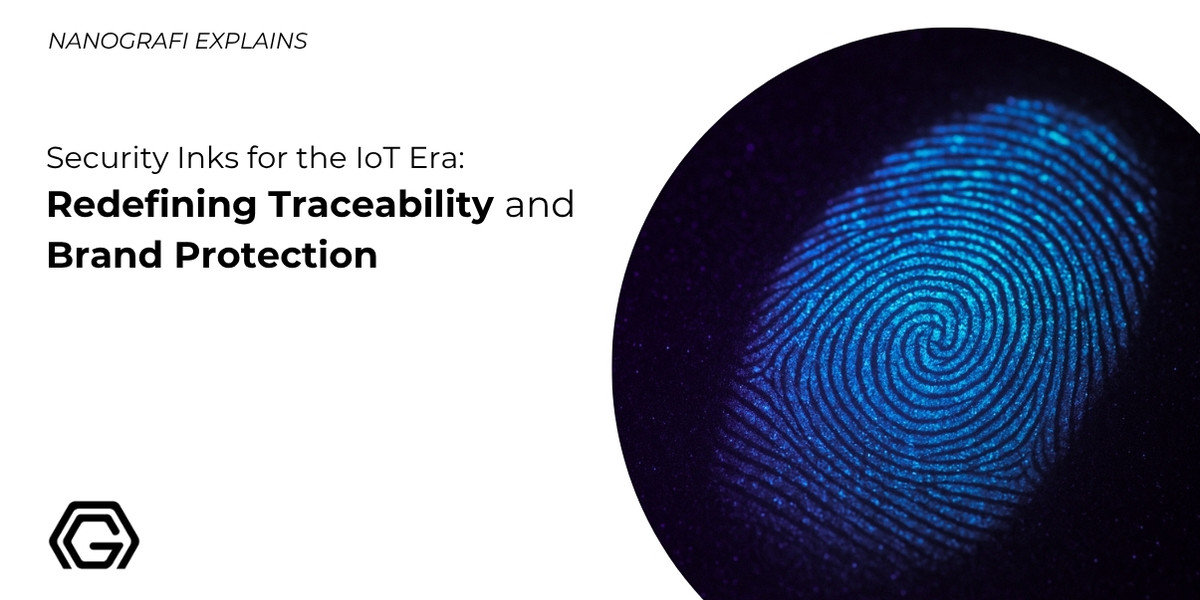Security Inks for the IoT Era: Redefining Traceability and Brand Protection
Introduction
The convergence of digital and physical domains has transformed product authentication from a visual verification task into a complex field of material and information security. In an increasingly interconnected industrial ecosystem, the reliability of supply chains depends on the ability to guarantee the origin, integrity, and traceability of physical goods. Conventional protection methods -such as holograms, serial codes, and barcodes- offer limited resilience against replication and manipulation, particularly in automated and IoT-based verification environments.
Nanografi develops functional security inks that combine nanomaterial science, optical engineering, and digital compatibility to establish a new standard in product protection. These advanced formulations integrate UV-responsive, IR-detectable, and graphene inks, transforming printed layers into tamper-evident identifiers capable of secure interaction with IoT infrastructures. When applied to packaging, these inks enable encrypted communication, real-time authentication, and transparent traceability across the entire supply chain (Isohanni et al., 2022; Hakola et al., 2021).

By merging molecular innovation with intelligent connectivity, security inks redefine how authenticity is engineered; offering brand owners, regulatory bodies, and consumers an unbroken chain of trust.
Functional Foundation of Security Inks
Optical and Chemical Intelligence
Security inks derive their strength from the interplay between functional pigments and responsive chemical structures. UV and IR inks reveal specific visual cues under controlled illumination, while color-shifting formulations alter their hue depending on viewing angle, providing multiple layers of protection.
Nanografi’s graphene inks add another dimension by providing superior electrical conductivity and signal stability. This enables them to function as Printed Electronic (PE) components (such as printed RFID antennae or simple sensors), allowing for direct digital interaction with embedded IoT readers. These materials combine high durability with chemical resistance, ensuring reliability in harsh production environments.

Through these mechanisms, security inks act as intelligent materials, capable not only of visual signaling but also of participating in digital verification processes (Liu et al., 2019).
Tackling Counterfeiting and Traceability Challenges
Multi-Layered Protection for Critical Industries
Counterfeiting continues to pose serious threats to industries ranging from pharmaceuticals and defense to luxury goods. Security inks address this by combining optical variability, unique material composition, and digital verification.
For example, UV-responsive or thermochromic layers can expose unauthorized alterations, while IR-detectable patterns allow machine-level authentication even in opaque or multilayer packaging systems. Each printed signature acts as a cryptographic marker, uniquely tied to production data and batch origin, enabling secure traceability throughout global distribution networks (Hakola et al., 2021).
Integration with IoT Verification Networks
In IoT-based packaging architectures, functional inks become data conduits. Once scanned, the unique optical or electrical signature of the ink pattern is read as a digital identifier (ID) and transmitted to a blockchain or cloud-based system for verification and product tracking. This linkage forms a dual structure: a physical layer (the printed ink with its optical signature) and a digital layer (the verification data).
Research by Isohanni et al. (2022) demonstrated how functional inks embedded in smart tags can authenticate products in fast-moving consumer goods. Similarly, Nanografi’s R&D on graphene-enhanced and UV-activated inks extends these capabilities into industrial-grade packaging, ensuring real-time authentication and tamper evidence even under demanding environmental conditions.
Smart Inks and the Future of Connected Packaging
Embedding Digital Identity into Matter
In modern connected systems, packaging no longer functions merely as a container but as an information interface. Security inks enable this transformation by embedding unique identifiers that communicate with digital infrastructures such as blockchain, NFC, and RFID.
When paired with IoT technologies, these functional inks can record data about temperature, humidity, or storage conditions, either by acting as self-responsive indicators (such as thermochromic/hygrochromic inks) or as graphene-based printed electronic sensors. This capability turns each product into a responsive data node within an intelligent supply chain. Printed electronics research further supports this trend, showing how conductive and photonic inks can enable active data communication (Chandrasekaran et al., 2022).
Sustainability and Environmental Compliance
Nanografi’s innovation strategy integrates eco-responsible ink systems with advanced performance metrics. Low-VOC, water-based, and biodegradable formulations minimize environmental impact while maintaining high color fidelity and signal response. Compliance with REACH and RoHS standards ensures that security inks not only protect brands but also support sustainable industrial practices (Liu et al., 2025).
This dual focus -security and sustainability- represents a new paradigm where material innovation reinforces both trust and environmental stewardship.
Conclusion
Security inks have evolved from simple colorants into data-driven materials that connect physical assets to digital ecosystems. By integrating UV, IR, and graphene-based functionalities, they establish a new benchmark for authentication, traceability, and brand protection.
Nanografi’s advanced ink portfolio exemplifies this shift. Each formulation is engineered to operate at the interface of chemistry, optics, and information science—bridging physical substrates and digital validation systems. As IoT-driven manufacturing expands, security inks will remain the core enabler of transparent, tamper-evident, and sustainable packaging architectures (Liu et al., 2019).
Learn more about Nanografi’s next-generation security ink technologies at https://inks.nanografi.com/
References
Chandrasekaran, S., Yao, L., Liu, Y., Qin, Y., & Du, S. (2022). A comprehensive review on printed electronics. Micromachines, 13(11), 1818. https://pmc.ncbi.nlm.nih.gov/articles/PMC9740290/?utm_source=chatgpt.com
Hakola, L., Vehmas, K., & Smolander, M. (2021). Functional inks and indicators for smart-tag-based intelligent packaging applications. Journal of Applied Packaging Research, 13(2). https://repository.rit.edu/japr/vol13/iss2/3/?utm_source=chatgpt.com
Isohanni, J., Virtanen, S., & Kunnari, E. (2022). Use of functional ink in a smart tag for fast-moving consumer goods industry. Journal of Packaging Technology and Research, 6(1), 59–69. https://link.springer.com/article/10.1007/s41783-022-00137-4?utm_source=chatgpt.com
Liu, Y., Zhang, X., & Peng, M. (2019). Inkjet-printed unclonable quantum dot fluorescent anti-counterfeiting labels. Nature Communications, 10, 2409. https://www.nature.com/articles/s41467-019-10406-7?utm_source=chatgpt.com
Liu, S., Han, Z., & Luo, X. (2025). A comprehensive review on inkjet-printed intelligent food packaging materials: Principle, ink formulation, functional inks and potential applications. Food Frontiers, 6(4). https://iadns.onlinelibrary.wiley.com/doi/full/10.1002/fft2.70034?utm_source=chatgpt.com
Nanografi Nano Technology. (n.d.). Security Inks. Retrieved October 2025 from https://inks.nanografi.com/
Recent Posts
-
Beyond Reduced Graphene Oxide: Discover Nanografi’s Advanced rGO-TEPA
As research in advanced materials expands, graphene derivatives with engineered surface chemistry a …17th Nov 2025 -
High-Tech Meets High Fashion: Conductive Inks for Smart Textiles
Fashion has always been an expression of identity, but now it has become a medium of interaction. To …7th Nov 2025 -
How Security Inks Solved the Era of Document Fraud
From Hollywood forgeries to high-tech prevention Remember Catch Me If You Can? Frank Abagnale’s leg …24th Oct 2025




